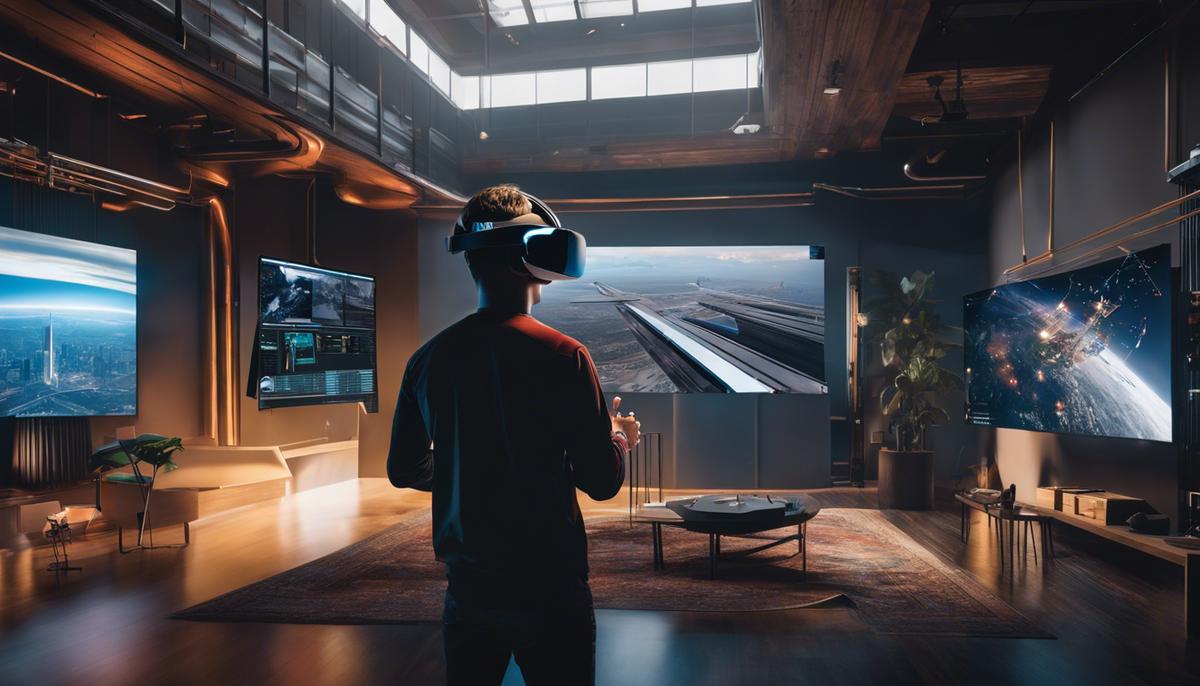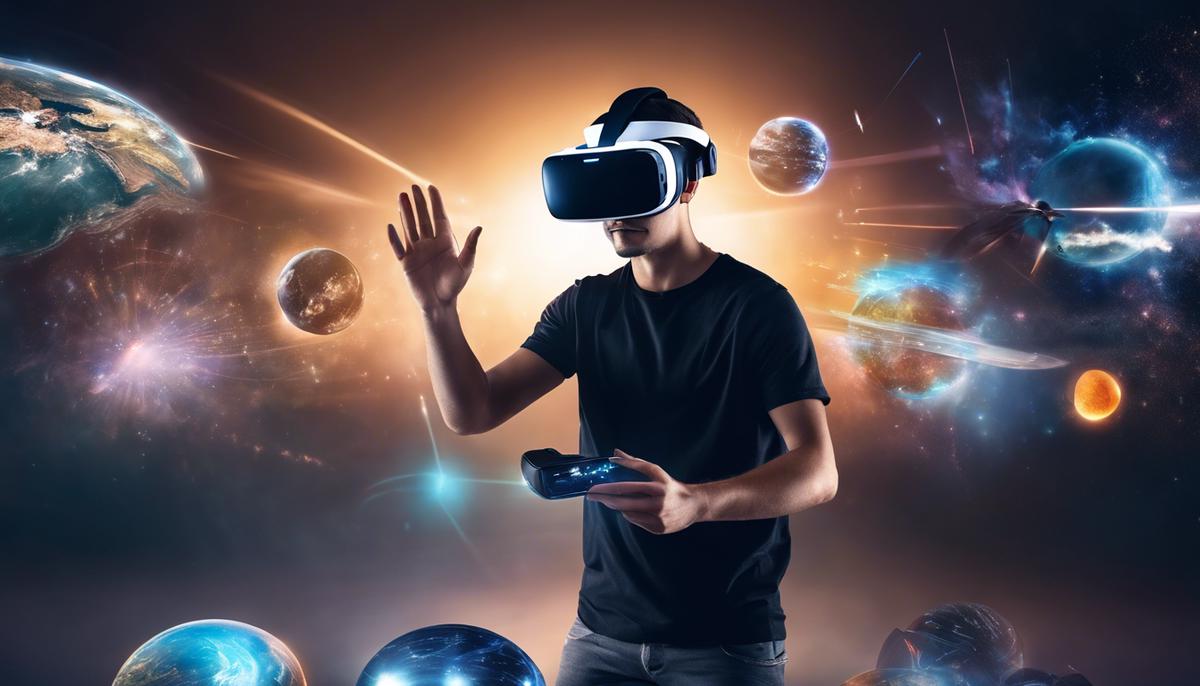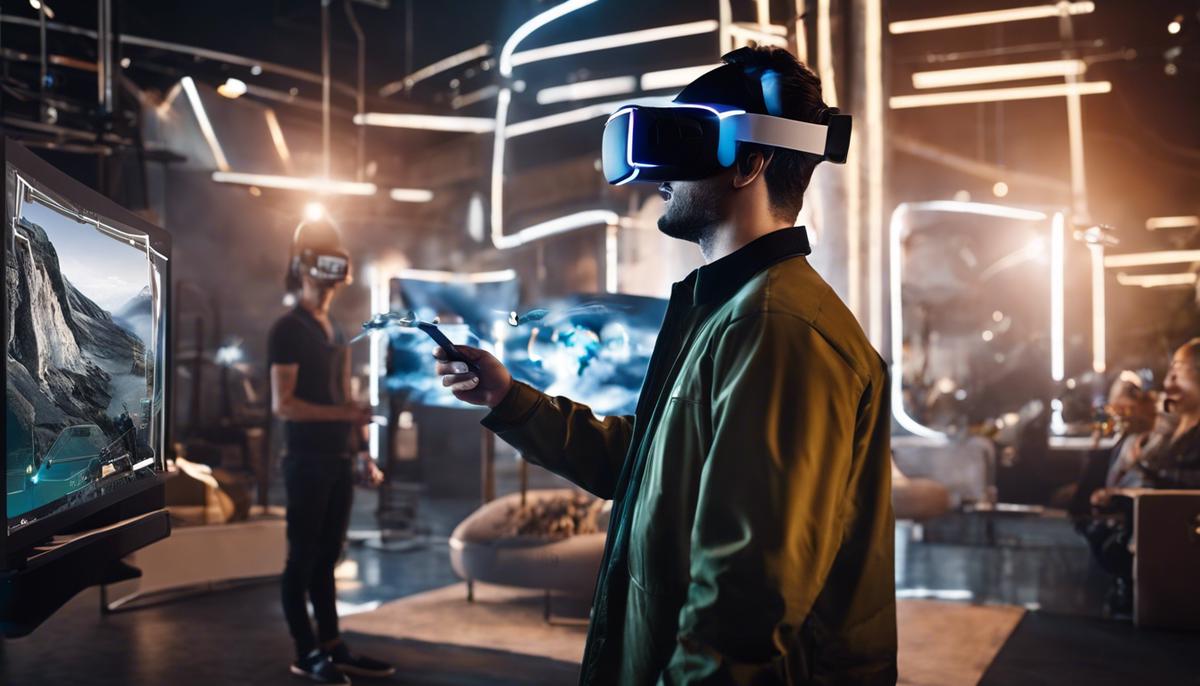In an era where technology is continually evolving and pushing boundaries, Virtual Reality (VR) and Augmented Reality (AR) have become transformative forces shaping how we interact with the world and each other. This essay endeavors to demystify and precisely define these technologies, shedding light on their salient features, strengths, and potential weaknesses. You will uncover their core technical aspects and numerous use-cases, exploring an array of applications from gaming, training, remote work, to social activities. A deep analysis will also be carried through to comprehend the technological frameworks that make these applications possible, offering a thorough analytic perspective of both VR and AR.
VR and AR: Demystification and Basic Definitions
Virtual Reality and Augmented Reality: Where They Stand in Today’s Tech Landscape
Virtual reality (VR) and Augmented reality (AR) have permeated the current tech landscape, making significant strides forward in transforming how we perceive our world and interact with digital environments. Not merely confined to the domains of gaming and entertainment, both technologies are painting a refreshed perspective on sectors ranging from healthcare to manufacturing.
The VR market has witnessed robust progress thanks to the likes of Oculus Quest 2 – a standalone VR headset offering the immersive experience without the need for high-powered, tethered PCs. Further reducing entry barriers and democratizing VR, PlayStation has also contributed significantly with its VR advancements.
Apart from gaming, there’s been an upsurge in VR applications in training and simulation fields. VR’s immersive capabilities make it an exemplary tool for training scenarios across various professions: from surgeons practicing delicate procedures to pilots navigating flight simulators.
Virtual meetings and conferences are also under the influence of VR. Spatial, a VR platform, illustrates the potential that a fully immersive, virtually collaborative environment offers. Attendees can interact more naturally, fostering an experience more akin to being physically together.
On the other hand, AR is beginning to make waves in the consumer and enterprise tech ecosystems. Consumers are well-acquainted with AR through popular applications like Snapchat filters and Pokémon Go. Advancements such as Apple’s ARKit and Google’s ARCore have accelerated the development of mobile AR apps, introducing interactive digital elements onto real-world scenes.
AR has grown beyond fun apps though; there are practical applications too. Augmenting the manufacturing and retail industries, AR can offer virtual prototyping and enhance the buying experience by letting customers visualize how products may look in the real world.
Microsoft’s efforts with HoloLens 2, an AR headset, have caught attention in the enterprise sector. The device enables workers to access digital information and overlays in the real world, enhancing productivity, facilitating remote collaboration, and improving training procedures.
Greater accessibility and user-friendly interfaces have made VR and AR more mainstream, but the journey is far from over. Challenges like affordability, hardware limitations, and the lack of high-quality content currently bottleneck the potentials of both VR and AR.
However, with tech giants like Google, Apple, Facebook, and Microsoft investing heavily in R&D, the prospects for VR and AR in the future appear promising. These technologies will certainly redefine human-machine interactions by permeating more deeply into everyday lives and industrial practices, further blurring the lines between the physical and digital world. It’s a thrilling time to appreciate and anticipate the unfolding potentials of VR and AR in the current tech landscape. Thus, it’s fair to say that this is just the beginning.

Technical Aspects and Use Cases
Delving Deeper into VR and AR: Technical Aspects and Unique Use Cases Uncovered
To comprehend the distinctions between VR (Virtual Reality) and AR (Augmented Reality), a deep dive into their technical areas is crucial. Both technologies offer immersive experiences, but they accomplish it in dramatically different ways.
In terms of technical specifications, VR requires a fully occluding headset, such as Oculus Rift. The setup essentially engulfs the users’ visual field in an artificial world, creating an illusion of being elsewhere. In contrast, AR overlays digital information onto the real world, essentially supplementing reality. For instance, Google Glass or the HoloLens 2 enables users to see the real world supplemented with holograms and additional data.
VR demands greater computational resources than AR as it has to create the entire visual field from scratch, resulting in highly detailed and realistic graphic displays. On the other hand, while AR also requires potent processing power to overlay digital content seamlessly onto the real world, it uses existing physical surroundings to anchor virtual objects.
Away from the general consumer market, these technologies find specialized applications in several sectors. The healthcare industry is a prime example. Surgeons use VR for detailed procedural rehearsals, significantly reducing surgical complications. Conversely, AR becomes an asset in real-time surgeries, where doctors overlay patient scans onto the body, increasing precision and reducing error margins.
Education is another sector where VR and AR are carving a niche. In essence, VR is often leveraged to create immersive learning environments, transporting students to different eras or even deep into cell structures. AR, meanwhile, provides interactive textbooks or lab demonstrations, enhancing content understanding without leaving the classroom. Furthermore, both technologies are revolutionizing accessibility in education, creating unprecedented learning experiences for individuals with special needs.
Moreover, in the field of entertainment and gaming, VR tends to offer completely immersive gaming experiences that require players to interact with a virtual world. AR games, however, are often location-based, integrating digital elements into real-world environments, with runaway hits such as Pokemon Go being prime examples.
It’s intriguing to envision how VR and AR technologies will evolve further. As developers push past technical limitations and architects explore new use cases, it’s evident that these technologies will play a pervasive role in multiple facets of modern life. In conclusion, the lines distinguishing VR from AR are not just in their technical implementations, but significantly in their varied application contexts and potential impact across different industries.

Future Outlook and Market Predictions
Stepping Beyond Boundaries: VR and AR in our Future
In the race to shape the digital future and broaden technology horizons, two champions are leading the charge: Virtual Reality (VR) and Augmented Reality (AR). Having thoroughly dissected the current landscape and applications of VR and AR, it’s time to project into the expanded realm of possibilities their continued evolution promises.
Harnessing the Power of AR in Health Care
AR, meeting the realms of medicine and healthcare, is set to redefine patient treatment and practitioners’ accuracy. Owing to its capability to superimpose virtual images on real-world objects, AR allows healthcare professionals to visualize complex medical conditions in three dimensions. This may include viewing layered anatomical structures, enabling surgeons to perform with pin-point accuracy.
Immersive Learning with VR
As a teaching tool, VR provides room for progressive learning experiences. VR is poised to revolutionize the education landscape. Imagine biology students exploring the human body, not merely from textbook illustrations, but as a tangible walk-through within a complex organism – VR provides that possibility. It creates a safe, controlled and interactive environment where students can practice, experiment, and learn at their own pace.
Turning Gaming Into a Real-World Experience with AR
Building on the established foundation in mobile gaming, AR is progressively blurring the line between digital and physical gaming spaces. The success of location-based game pioneers like Pokémon GO has proven the market potential for AR-integrating games. The immersive and interactive nature of AR will continuously captivate gamers, calling for newer, more engaging experiences.
Precision Tapping with VR
VR isn’t limited to gaming and education: its influence permeates into visually intensive professions, such as architecture and engineering design. By allowing a fully immersive 3D visualization, VR permits architects to explore, modify, and interact with their designs in real-time, leading to precision-tapped design outcomes.
Revolutionary Impacts of VR and AR
As VR and AR technologies continue to evolve, substantial transformations of key industries are plausible. From retail and manufacturing to healthcare and education, both mediums can impact worker productivity, customer engagement, and service quality extensively.
In the realm of manufacturing, AR could expedite processes by providing real-time guidance to workers, whereas in retail, a virtual dressing room could redefine the shopping experience. For the service sectors, VR and AR create opportunities from remote healthcare consultations to virtual field trips for students.
The future of VR and AR is teeming with potential, overstepping the boundaries of industries and entering an age of seamless integration within daily life. These technologies are not mere trends, but central players in the future landscape of global technology. Despite the practical and technical challenges they face, their transformative potential remains undeniably captivating. Only time will tell how these immersive technologies will reshape our world. But one thing is for sure – these realities, virtual and augmented, are already pivoting us towards a future beyond imagination.

As we look beyond the horizon, poised on the pinnacle of technological advancements, VR and AR hold immense potential. The future of these technologies paints an exciting and technologically sophisticated image filled with remarkable developments and practical implications. VR and AR are not merely concepts but tangible realities crafting new market trends, creating novel products, and reinventing corporate and lifestyle scenarios. Step into the revolution where digital experiences and the real world converge, transforming our perception and interaction with the world around us. Embrace this technological innovation that promises to create dynamic and versatile layers of experience, adding a whole new dimension to our reality.
